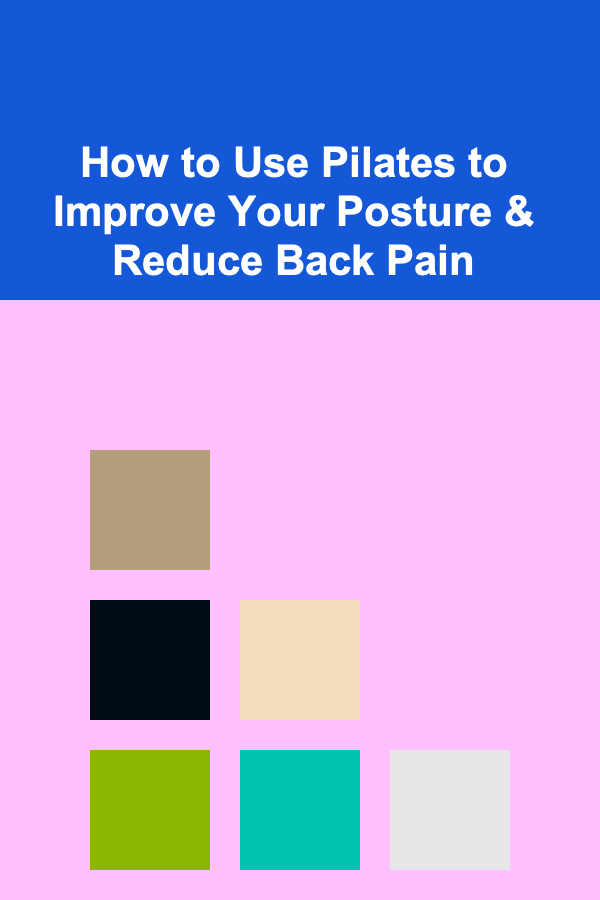
How to Use Pilates to Improve Your Posture & Reduce Back Pain
ebook include PDF & Audio bundle (Micro Guide)
$12.99$9.99
Limited Time Offer! Order within the next:

Posture and back pain are two of the most common issues affecting people today. Whether it's from long hours spent at a desk, improper lifting techniques, or simply the natural wear and tear of aging, many individuals suffer from poor posture and chronic back pain. Fortunately, Pilates---a low-impact form of exercise that focuses on core strength, flexibility, and alignment---has been shown to be highly effective in improving posture and reducing back pain.
In this comprehensive guide, we'll explore how Pilates can help improve your posture, alleviate back pain, and enhance your overall well-being.
Understanding Posture and Back Pain
What is Posture?
Posture refers to the way we hold our bodies when sitting, standing, and moving. Proper posture means that your body is aligned in such a way that the bones, muscles, and ligaments can work efficiently. Good posture helps maintain balance, reduces strain on muscles and joints, and supports the proper functioning of your internal organs.
On the other hand, poor posture can lead to an imbalance in the body. It can cause discomfort, muscle strain, joint problems, and even affect breathing and digestion.
Causes of Poor Posture
There are numerous factors that contribute to poor posture, including:
- Sedentary Lifestyle: Spending long periods sitting at desks or in front of screens leads to rounded shoulders, slouched backs, and tight hip flexors.
- Weak Core Muscles: The core muscles (which include the abdominals, back muscles, and pelvic floor) play a critical role in maintaining good posture. When these muscles are weak, they cannot support the spine effectively, leading to poor alignment.
- Stress and Tension: Stress can cause us to tense our shoulders and neck muscles, leading to slumped posture and discomfort.
- Injury: Previous injuries to the back, neck, or hips can cause compensatory movements that affect overall posture.
- Aging: As we age, the muscles that support our posture may weaken, and the spine can become more susceptible to misalignment or degeneration.
The Link Between Posture and Back Pain
Poor posture is one of the leading causes of chronic back pain. When the body is not aligned correctly, it can put excess pressure on the spine, muscles, and joints. Over time, this pressure can lead to muscle strain, tension, and even spinal misalignment, all of which contribute to back pain.
Some common types of back pain linked to poor posture include:
- Lower back pain: Often caused by slouching or sitting for extended periods.
- Upper back pain: Can result from rounded shoulders and forward head posture, common in people who spend hours looking down at phones or computers.
- Neck and shoulder pain: Frequently caused by tension from poor posture and sitting for long periods.
By improving posture through exercises like Pilates, you can help restore proper alignment, reduce muscle tension, and prevent long-term back pain.
How Pilates Can Help Improve Posture and Reduce Back Pain
Pilates is a form of exercise developed by Joseph Pilates in the early 20th century. It focuses on strengthening the core muscles, improving flexibility, and enhancing body awareness. Pilates exercises can be performed on a mat or using specialized equipment such as reformers, chairs, and barrels.
1. Strengthening the Core Muscles
The core is the foundation of good posture. It consists of the muscles in your abdomen, lower back, and pelvic floor, which all work together to support your spine and maintain balance. When your core is weak, your spine is more vulnerable to misalignment, leading to poor posture and back pain.
Pilates exercises target the deep abdominal muscles, the obliques (side abdominal muscles), and the muscles along the spine. By strengthening these muscles, you create a solid foundation of support for your body, helping to improve your posture and reduce the risk of injury.
Key Pilates Exercises for Core Strength:
- The Hundred: This exercise focuses on building endurance in the core while also engaging the arms and legs.
- Plank: A classic Pilates exercise that engages the entire core and improves stability.
- Roll Up: Helps strengthen the abdominals and improve spinal flexibility.
- Leg Circles: Targets the deep core muscles and helps stabilize the pelvis and spine.
2. Improving Flexibility and Mobility
Tight muscles, especially in the back and hips, are a common cause of poor posture and back pain. Flexibility and mobility exercises, such as those found in Pilates, can help relieve tightness in the muscles and improve range of motion.
Pilates movements encourage a full range of motion in the spine, hips, and shoulders, promoting flexibility and helping the body move more freely. As you stretch and lengthen muscles through controlled movements, you reduce the risk of muscle stiffness and tension, which can contribute to poor posture and pain.
Key Pilates Exercises for Flexibility and Mobility:
- Cat-Cow Stretch: This exercise improves spinal mobility and helps relieve tension in the back and neck.
- Saw: A seated stretch that targets the hamstrings and lower back.
- Spine Stretch Forward: Focuses on lengthening the spine and stretching the hamstrings.
- Knee Fold: Engages the lower back and hips while stretching the legs and improving spinal alignment.
3. Enhancing Body Awareness
Pilates places a strong emphasis on controlled, mindful movement. By focusing on how each movement feels and paying attention to your alignment, Pilates helps improve body awareness. This heightened awareness enables you to recognize when your posture is off and make adjustments before discomfort or pain sets in.
In addition, Pilates teaches you how to engage the right muscles during everyday activities, helping you maintain proper posture throughout the day. For example, Pilates can teach you how to sit up straight in a chair, stand tall, or pick up objects using correct body mechanics to avoid strain on the back.
4. Correcting Imbalances and Misalignments
Many individuals have muscle imbalances, where one side of the body is stronger or tighter than the other. These imbalances can lead to postural issues and contribute to back pain. Pilates is an excellent tool for correcting these imbalances, as many Pilates exercises involve working both sides of the body equally.
For example, some Pilates movements target the muscles along the spine and lower back, while others focus on the hips and shoulders. By working both sides of the body evenly, you can correct muscle imbalances, restore proper alignment, and reduce the likelihood of back pain.
5. Encouraging Proper Alignment
Pilates encourages spinal alignment and proper body positioning in every exercise. Proper alignment ensures that the spine is in its natural curves, reducing the risk of strain or injury.
One of the key principles of Pilates is maintaining a neutral spine, which means that the natural curves of the spine (the cervical, thoracic, and lumbar curves) are maintained throughout each movement. This is important because misalignment of the spine can contribute to muscle tension, poor posture, and back pain. Pilates movements emphasize control, precision, and alignment, helping to train the body to move efficiently and without pain.
A Beginner's Guide to Pilates for Posture and Back Pain
Getting Started with Pilates
If you're new to Pilates, it's important to start with the basics and gradually progress to more advanced exercises. Here's a beginner-friendly routine that you can follow to start improving your posture and reducing back pain:
- Breathing: Begin by focusing on your breath. Proper breathing is essential in Pilates, as it helps engage the core muscles and maintain control during movements. Inhale deeply through the nose, filling the lungs, and exhale fully through the mouth.
- Pelvic Tilts: Start by lying on your back with your knees bent and feet flat on the floor. Gently tilt your pelvis upward and then back down to neutral. This movement helps activate the lower abdominals and begin engaging the core.
- Bridge Pose: Lying on your back with your knees bent and feet flat on the floor, lift your hips toward the ceiling while squeezing your glutes and engaging your core. This exercise strengthens the lower back and helps align the spine.
- The Hundred: Lie on your back with your legs lifted at a 45-degree angle and arms extended by your sides. Begin pumping your arms up and down while breathing in for five counts and out for five counts. This exercise targets the core and increases endurance.
- Cat-Cow Stretch: Start on your hands and knees. Arch your back as you inhale, lifting your head and tailbone. Exhale and round your spine, tucking your chin toward your chest. This exercise increases flexibility in the spine and relieves tension.
Pilates for Back Pain Relief
If you are dealing with chronic back pain, Pilates exercises can help alleviate discomfort by strengthening the muscles that support the spine and improving flexibility. Start with simple, low-impact movements, and gradually work your way up to more challenging exercises as your strength and flexibility improve.
Pilates Routine for Back Pain Relief:
- Knee Folds: Lie on your back with your knees bent. Slowly lift one knee toward your chest, then lower it back down. Repeat on the other side. This exercise engages the lower abs and strengthens the muscles around the spine.
- The Saw: Sit up with your legs extended wide apart. Reach your opposite hand toward your pinky toe, rotating your torso as you reach. This exercise stretches the back and improves spinal mobility.
- Spine Stretch Forward: Sit up tall with your legs extended in front of you. Slowly hinge forward from your hips, reaching your hands toward your feet. This exercise stretches the back and hamstrings while promoting proper spinal alignment.
Final Thoughts
Pilates is a highly effective method for improving posture and reducing back pain. By focusing on core strength, flexibility, alignment, and body awareness, Pilates can help restore balance to the body, correct muscle imbalances, and promote spinal health. Whether you're dealing with chronic back pain or simply want to improve your posture, Pilates offers a safe and gentle approach to enhancing overall well-being.
Remember to start slowly, listen to your body, and gradually increase the intensity of your practice. Consistency is key, and over time, you'll notice significant improvements in your posture, reduced back pain, and a greater sense of overall strength and stability.
Reading More From Our Other Websites
- [Home Security 101] How to Secure Your Home While on Vacation
- [Home Staging 101] How to Use Lighting to Highlight Your Home's Best Features
- [Personal Finance Management 101] How to Plan for College Tuition and Student Loan Repayment
- [Home Pet Care 101] How to Make Your Pet Feel Comfortable at Home: Tips for a Stress-Free Environment
- [Home Lighting 101] How to Create a Calming and Safe Nursery Lighting Plan
- [Organization Tip 101] Why Regularly Reassessing Your Stuff is Necessary
- [Personal Financial Planning 101] How to Invest in Retirement: Maximizing Your Savings
- [Home Cleaning 101] How to Clean and Sanitize Your Washing Machine
- [Tiny Home Living Tip 101] How to Maximize Natural Light in a 200‑Square‑Foot Tiny House Design
- [Personal Investment 101] How to Navigate the Stock Market for Beginners

Best Organization Tools for Fitness Enthusiasts
Read More
How To Safely Use Biometric Authentication
Read More
How to Use Investment Apps to Track and Manage Your Portfolio
Read More
How to Meal Plan for Busy Professionals
Read More
How to Create a Social Media Content Calendar for Rescue Animals
Read More
How to Budget for Homeownership When You're Self-Employed
Read MoreOther Products

Best Organization Tools for Fitness Enthusiasts
Read More
How To Safely Use Biometric Authentication
Read More
How to Use Investment Apps to Track and Manage Your Portfolio
Read More
How to Meal Plan for Busy Professionals
Read More
How to Create a Social Media Content Calendar for Rescue Animals
Read More